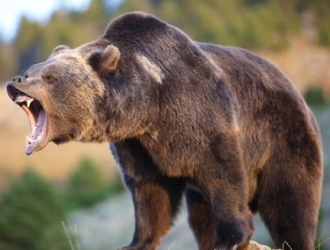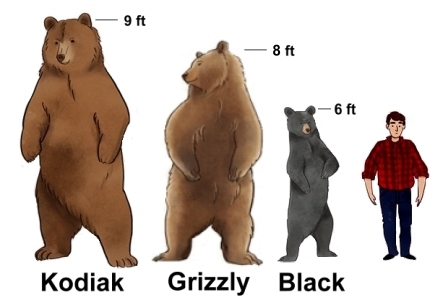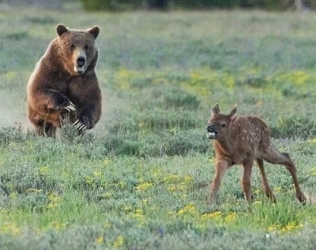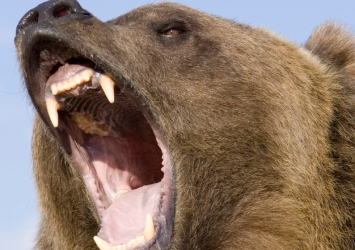 Ursus arctos horribilis  The grizzly bear is a North American subspecies of the brown bear. Grizzlies are a solitary animal, and are
typically brown, and their fur can appear to be white-tipped, or grizzled, hence their name. They can also be white, yellow-white, or even black!
The grizzly bear is a North American subspecies of the brown bear. Grizzlies are a solitary animal, and are
typically brown, and their fur can appear to be white-tipped, or grizzled, hence their name. They can also be white, yellow-white, or even black! The grizzly bear is a massive animal with humped shoulders caused by the large muscles in the bear's front legs. The term grizzly bear, however, is sometimes applied informally to brown bears of North America regardless of the subspecies. Large adult grizzlies can be about 2.5 metres (8 feet) tall when standing on their hind legs, and weigh over 400 kg (900 pounds). They rarely climb trees, but they are surprisingly agile, and can run as fast as 56 km per hour over short distances. Their eyesight is poor, and they have been known to attack humans without provocation. Females with cubs are the most aggressive. The grizzly bear's range includes the Northwest territories, Nunavut, Yukon, British Columbia, Manitoba, Alberta, and Saskatchewan.  Grizzly bears have to be able to survive the very different seasons in North America. In summer, they eat a massive amount of food so they can live off body fat during the winter, when food is scarce.
Grizzly bears have to be able to survive the very different seasons in North America. In summer, they eat a massive amount of food so they can live off body fat during the winter, when food is scarce. Though it's the second largest land carnivore in North America, plants can make up a large part of its diet. Grizzlies are omnivores, and will eat anything they can find, including nuts, fruit, leaves, roots, fungi, insects, and a variety of animals including salmon and other fish, rodents, sheep, and elk. Their diet varies depending on what foods are available for the season. Bears, including the grizzly, aren't true hibernators. In fact, they can be active, if lethargic, for the whole winter. Grizzlies have sharp, curved claws up to five inches long on their front feet that are used for digging up food such as roots, rodents, and invertebrates, catching fish, tearing apart rotten logs in search of food, or slicing into plant or animal matter. Food is often stored in shallow holes they dig.  Cubs, usually twins, are born in January or February after about six to eight months of gestation. They are very small, weighing only 4 kg when born. Grizzlies have a lifespan of 20-30 years.
Cubs, usually twins, are born in January or February after about six to eight months of gestation. They are very small, weighing only 4 kg when born. Grizzlies have a lifespan of 20-30 years.
Grizzlies remain numerous in Alaska and Canada. In the continental United States, however, fewer than 1,500 remain, and they are protected by law. In Canada, the grizzly bear is also protected by hunting regulations; currently only in the Yukon can grizzlies be hunted, with the exception of Aboriginal subsistence hunting. One of the biggest threats to the grizzly is people. They are often killed by people who are defending themselves or their property, by collisions with vehicles, by those who mistake them for legal game during a hunt, and by those hunting illegally. They also are affected by habitat loss.  Grizzly bears are not the biggest North American land predator. That distinction belongs to the polar bear, and the Kodiak bear. Kodiak bears, a subspecies of brown bear, inhabit Alaska’s Kodiak Island and nearby islands, are sometimes called grizzlies because of their superficial physical similarities to grizzly bears. However, Kodiak bears are larger in size, and the ranges of Kodiak bears and grizzly bears do not overlap. Similarly, American black bears are sometimes mistaken for grizzly bears because their colour is sometimes brown in the western parts of their range. Kodiak bears can weigh up to 720 kg (1,600 pounds); their population numbers about 3,500 animals.
Grizzly bears are not the biggest North American land predator. That distinction belongs to the polar bear, and the Kodiak bear. Kodiak bears, a subspecies of brown bear, inhabit Alaska’s Kodiak Island and nearby islands, are sometimes called grizzlies because of their superficial physical similarities to grizzly bears. However, Kodiak bears are larger in size, and the ranges of Kodiak bears and grizzly bears do not overlap. Similarly, American black bears are sometimes mistaken for grizzly bears because their colour is sometimes brown in the western parts of their range. Kodiak bears can weigh up to 720 kg (1,600 pounds); their population numbers about 3,500 animals.
  If you are attacked by a brown or grizzly bear, leave your pack on and play dead. Lay flat on your stomach with your hands clasped behind your neck. Spread your legs to make it harder for the bear to turn you over. Remain still until the bear leaves the area. Fighting back usually increases the intensity of the attack. However, if the attack persists, fight back vigorously. Use whatever you have at hand to hit the bear in the face.
If you are attacked by a brown or grizzly bear, leave your pack on and play dead. Lay flat on your stomach with your hands clasped behind your neck. Spread your legs to make it harder for the bear to turn you over. Remain still until the bear leaves the area. Fighting back usually increases the intensity of the attack. However, if the attack persists, fight back vigorously. Use whatever you have at hand to hit the bear in the face.If you are attacked by a black bear, do not play dead. Try to escape to a secure place. If escape isn't possible, try to fight back using any object available. Concentrate your kicks and blows on the bear's face and muzzle.   |